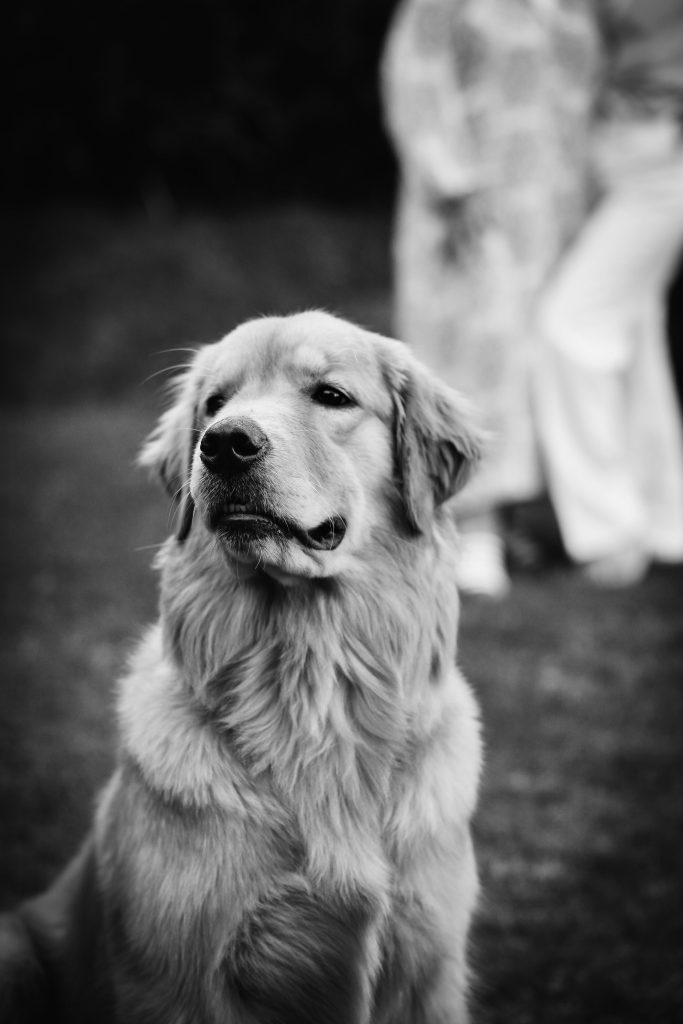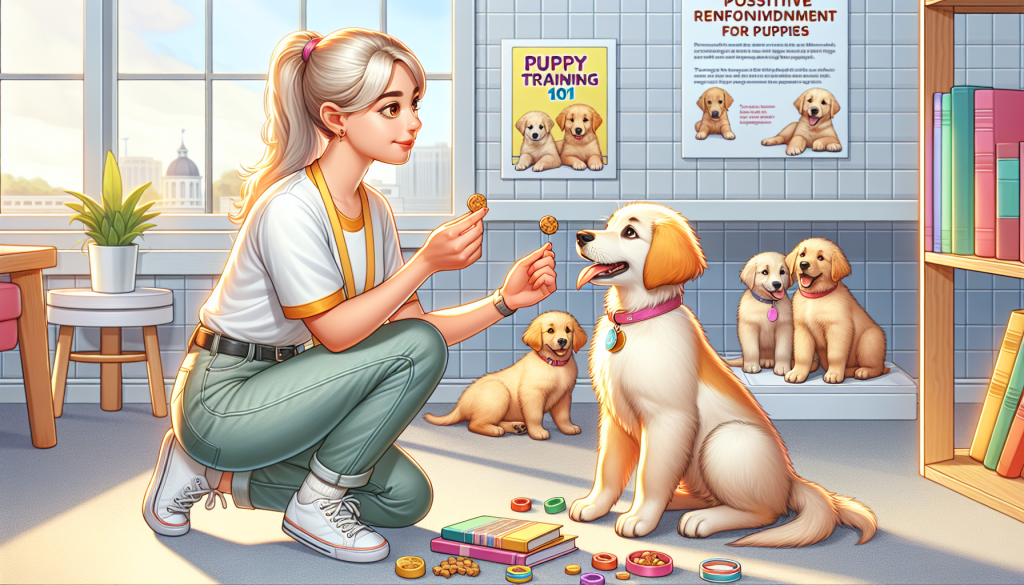So you’ve just brought home a new bundle of joy in the form of a playful, energetic puppy. It’s hard not to fall head over heels for those adorable, floppy ears and wagging tail, but what happens when your furry friend starts barking incessantly? Don’t worry, training your puppy not to bark can be done with a little patience and consistency. In this article, we’ll explore effective techniques and tips to help you foster a harmonious relationship with your four-legged companion, without the constant noise pollution. Say goodbye to the barks and hello to a peaceful home!
Understanding Why Puppies Bark
Puppies bark as a way to communicate their needs and emotions. Understanding the reasons behind their barking is essential for effective training. Some common reasons for puppy barking include seeking attention, expressing boredom or frustration, alerting to perceived threats, or simply playing and exploring their environment. By recognizing the motivations behind their barking, you can better address their needs and train them to bark less when appropriate.
Identifying the Reasons Behind Puppy Barking
To effectively address puppy barking, it is crucial to identify the underlying reasons. For example, if your puppy barks for attention, you can teach them alternative ways to get your attention, such as sitting quietly or using a specific command. If they are barking out of boredom, providing them with stimulating toys and activities can help redirect their energy. By pinning down the specific triggers for your puppy’s barking, you can tailor your training approach and find suitable solutions.
Recognizing Normal and Excessive Barking
While barking is a normal behavior for puppies, it is essential to differentiate between normal and excessive barking. Normal barking occurs in response to specific stimuli or situations, such as when someone rings the doorbell. Excessive barking, on the other hand, may be persistent, prolonged, and occur without a clear trigger. It is important to address excessive barking as it can disrupt your household and lead to neighbor complaints. Understanding the distinction allows you to intervene appropriately and teach your puppy when it is appropriate to bark.
The Importance of Addressing Excessive Barking
Addressing excessive barking is crucial for both your puppy’s well-being and the harmony of your home. Excessive barking can indicate underlying issues such as anxiety or frustration, and it is important to address these concerns for your puppy’s overall happiness. Moreover, excessive barking can strain relationships with neighbors and cause unnecessary stress. By addressing excessive barking early on, you can promote a calm and peaceful living environment for both your puppy and yourself.

This image is property of images.pexels.com.
Establishing a Good Relationship with Your Puppy
Building trust and bonding with your puppy is the foundation for effective training. Taking the time to establish a positive relationship sets the stage for successful communication and cooperation. Spend quality time with your puppy, engaging in activities they enjoy, and providing plenty of physical affection. This will help them feel secure and develop a strong bond with you, making them more likely to respond positively to training and guidance.
Establishing Yourself as the Pack Leader
As the owner, it is important to establish yourself as the pack leader in your puppy’s eyes. Dogs are naturally inclined to follow a strong, confident leader, and assuming this role will help them feel secure and obedient. Set clear boundaries, consistently enforce rules, and use firm but gentle commands. By providing guidance and structure, you establish yourself as a reliable leader, which in turn helps reduce excessive barking and encourages good behavior.
Using Positive Reinforcement for Good Behavior
Positive reinforcement is a highly effective training method for puppies. Rewarding your puppy’s good behavior with praise, treats, or playtime reinforces their understanding of what is expected of them. When your puppy exhibits quiet behavior, acknowledge and reward them. This positive reinforcement encourages them to repeat the desired behavior and helps shape their understanding of appropriate barking. By focusing on rewarding good behavior rather than punishing unwanted behavior, you can foster a trusting and cooperative relationship with your puppy.
Socializing Your Puppy
Socializing your puppy is essential for their development and helps prevent behavior problems, including excessive barking. Introducing your puppy to different people and animals from an early age teaches them to be comfortable and confident in various social situations. Arrange playdates with other friendly dogs, organize visits with friends and family, and expose your puppy to new environments and experiences. These interactions help your puppy learn appropriate behavior and reduce the likelihood of fear-based barking.

This image is property of images.pexels.com.
Introducing Your Puppy to Different People and Animals
Introduce your puppy to a wide range of people and animals to promote socialization. Gradually expose them to individuals of different ages, appearances, and personalities. This will help them become comfortable and friendly around diverse groups. Start with controlled interactions and gradually increase the complexity of the encounters. By providing positive experiences and ensuring your puppy feels safe during interactions, you can minimize the likelihood of excessive barking when meeting new people or animals.
Exposing Your Puppy to Various Environments
To ensure your puppy remains calm and composed in different environments, expose them to a variety of settings. Take them on walks through bustling streets, visit parks, and explore different areas in your community. Gradually introduce them to different sounds, smells, and sights, allowing them to acclimate to new experiences. By exposing your puppy to various environments, you help them develop confidence and reduce the likelihood of fear-based barking when faced with unfamiliar surroundings.
Encouraging Positive Interactions
Encouraging positive interactions with other people and animals is essential in preventing excessive barking. Provide opportunities for your puppy to engage in play and cooperative behavior. Arrange playdates with well-behaved dogs and supervise their interactions to ensure positive experiences. Similarly, reward your puppy for calm and friendly behavior around people. By reinforcing positive interactions and rewarding appropriate behavior, you can teach your puppy to engage with others without resorting to excessive barking.
Creating a Calm Environment
Creating a calm environment is crucial for reducing excessive barking and promoting your puppy’s overall well-being. By providing a safe and comfortable space for your puppy, you help alleviate anxiety and stress, which are common triggers for barking. Ensure your puppy has a designated area with their bed or crate, along with toys and chews for mental stimulation. Additionally, consider incorporating calming elements like classical music or pheromone diffusers to create a soothing atmosphere that promotes relaxation and reduces the likelihood of excessive barking.

This image is property of images.pexels.com.
Providing a Safe and Comfortable Space for Your Puppy
It is important to create a designated space that your puppy can call their own. This can be a crate, a bed, or a cozy corner in a room. Make sure it is comfortable and contains items that provide mental stimulation, such as puzzle toys or chew toys. An inviting and secure space allows your puppy to retreat and relax, reducing anxiety and the tendency to bark excessively.
Reducing Potential Triggers for Barking
Identifying and reducing potential triggers for barking is essential for maintaining a calm environment. Observe your puppy’s behavior and note what situations or stimuli cause them to bark excessively. For example, if they bark at people passing by the window, consider using curtains or window film to reduce their visibility. If outdoor noises are a trigger, use white noise machines or fans to mask the sounds. Minimizing or eliminating these triggers helps create a peaceful atmosphere and reduces the likelihood of excessive barking.
Ensuring Proper Physical and Mental Stimulation
Puppies, especially active breeds, require both physical and mental stimulation to prevent boredom and excessive barking. Engage in regular play sessions with toys, go for walks, and provide opportunities for them to explore their environment. Additionally, mental stimulation through puzzle toys or training sessions helps tire out your puppy’s mind. A tired and fulfilled puppy is less likely to engage in excessive barking, as they are content and satisfied with their physical and mental needs being met.
Teaching the ‘Quiet’ Command
Teaching your puppy the ‘Quiet’ command is a valuable tool in curbing excessive barking. This command teaches your puppy to stop barking on cue, providing you with a means to control their vocalization. To train this command, start by using a calm and assertive tone, along with a specific hand gesture. When your puppy barks, calmly say ‘Quiet’ and use the hand gesture. When they stop barking, praise and reward them with treats or playtime. Consistency and repetition are key in teaching this command, and with time, your puppy will learn to respond to the ‘Quiet’ cue.

Steps to Train Your Puppy to Be Quiet
To train your puppy to be quiet, follow these steps:
- Start in a controlled and quiet environment.
- When your puppy barks, say ‘Quiet’ in a calm and firm tone.
- Simultaneously use a specific hand gesture, such as putting your finger to your lips.
- As soon as your puppy stops barking, praise and reward them with treats or playtime.
- Consistently repeat this process whenever your puppy barks, gradually increasing the difficulty by adding distractions or triggers.
- With repetition and consistency, your puppy will learn to associate the ‘Quiet’ cue with stopping barking.
Using Positive Reinforcement Techniques
Positive reinforcement is key when teaching the ‘Quiet’ command. Rewarding your puppy for being quiet encourages them to repeat the desired behavior. Use treats, praise, or playtime as rewards when they respond to the ‘Quiet’ command. Consistency is essential in reinforcing this behavior, ensuring that your puppy understands the connection between being quiet and receiving positive reinforcement. Avoid using punishment-based methods, as they can lead to fear or anxiety, potentially worsening barking behavior.
Consistency and Patience in Training
Consistency and patience are vital when training your puppy to be quiet. It takes time for your puppy to understand and learn the ‘Quiet’ command. Consistently use the same hand gesture and verbal cue, and always reward them for their quiet behavior. Remember to be patient and understanding, as puppies may take longer to grasp the concept. By remaining consistent and patient, you give your puppy the opportunity to learn and develop the desired behavior.
Distracting and Redirecting Your Puppy
Distracting and redirecting your puppy’s attention is an effective technique to prevent excessive barking. When your puppy begins to bark, intervene by offering a toy or treat to divert their energy and focus. Engaging them in alternative activities such as fetch or puzzle toys helps redirect their attention and energy, reducing the likelihood of barking. This technique teaches your puppy to associate their barking with more constructive and engaging activities.

Using Toys or Treats to Redirect Barking
When your puppy starts barking, have a selection of toys or treats readily available. As soon as they bark, offer the toy or treat as a distraction. Encourage them to engage with the toy or enjoy the treat. By redirecting their focus onto a more appropriate and rewarding activity, you prevent excessive barking and provide an outlet for their energy and excitement.
Engaging Your Puppy in Alternative Activities
Engaging your puppy in alternative activities is essential in diverting their attention away from barking. Regular play sessions, puzzle toys, and interactive games help keep them mentally and physically stimulated. By providing a variety of activities, you can manage their energy levels and reduce the likelihood of boredom-induced barking. Remember to rotate the toys and activities to maintain their novelty and interest.
Teaching Your Puppy to Focus on Commands
Teaching your puppy to focus on commands is an effective way to redirect their attention away from barking. Training sessions that include commands such as ‘sit,’ ‘stay,’ or ‘lie down’ require your puppy to listen and concentrate. By giving them a task to focus on, you redirect their energy and discourage excessive barking. Rewarding them for following commands reinforces their understanding and encourages future obedience.
Addressing Separation Anxiety
Separation anxiety is a common cause of excessive barking in puppies. Recognizing the symptoms and addressing this issue is crucial for your puppy’s well-being. Symptoms of separation anxiety may include excessive barking, destructive behavior, pacing, or toileting indoors. To help your puppy overcome separation anxiety, gradually desensitize them to being alone by starting with short periods of separation and gradually increasing the duration. Additionally, providing comfort items, such as blankets with your scent or pheromone sprays, can help soothe your puppy during periods of separation.
Recognizing Separation Anxiety Symptoms
Understanding the symptoms of separation anxiety in your puppy is essential for effective intervention. Excessive barking, destructive behavior, or attempts to escape when left alone are common indicators of separation anxiety. Your puppy may also display restlessness, excessive salivation, or loss of appetite. By recognizing these symptoms, you can address separation anxiety promptly and implement strategies to help your puppy feel more secure and relaxed when left alone.
Gradually Desensitizing Your Puppy to Being Alone
To help your puppy overcome separation anxiety, gradual desensitization is key. Start by leaving them alone for short periods in a separate room while providing them with engaging toys or treats. Return before they start to exhibit signs of distress, and gradually increase the duration of your absences. This process helps your puppy learn that being alone is not a cause for alarm and builds their confidence in your eventual return. Remember to remain patient and consistent throughout this process, as overcoming separation anxiety can take time.
Using Comfort Items or Crate Training
Comfort items or crate training can provide a sense of security for puppies with separation anxiety. A blanket or clothing item with your scent can help soothe your puppy when you are away. Additionally, crate training provides a safe and enclosed space that mimics a den-like environment, making your puppy feel secure during your absence. Introduce crate training gradually, using positive reinforcement and rewards to create a positive association. With time and training, your puppy will view their crate as a safe haven, reducing anxiety-induced barking.
Knowing When to Contact a Professional Trainer or Behaviorist
In some cases, excessive barking may persist despite your best efforts. If you are unable to address the issue on your own or your puppy’s barking poses a significant challenge, it may be beneficial to seek professional help. A professional trainer or behaviorist can evaluate your puppy’s unique situation, provide expert guidance, and tailor a training plan specific to their needs. They have the expertise to address complex behavior issues, including excessive barking, and can offer specialized advice to ensure your puppy’s well-being and a peaceful household.
Getting Specialized Advice for Your Puppy’s Barking
A professional trainer or behaviorist can provide specialized advice for your puppy’s barking based on their individual needs and circumstances. They will assess the underlying reasons for your puppy’s excessive barking and develop a training plan that suits their temperament and behavior. This personalized guidance can help you address the issue effectively and ensure a positive and harmonious relationship with your puppy.
Understanding the Benefits of Professional Guidance
Seeking professional guidance for your puppy’s excessive barking offers numerous benefits. Professional trainers and behaviorists possess a wealth of knowledge and experience in canine behavior, enabling them to offer effective strategies to address excessive barking. They can accurately assess your puppy’s behavior and provide personalized solutions that take into account their unique needs. Additionally, professional guidance provides ongoing support, troubleshooting, and reassurance throughout the training process, ensuring you and your puppy receive the best possible guidance and outcomes.
Avoiding Punishment-Based Training Methods
While it can be tempting to resort to punishment-based training methods to discourage excessive barking, these techniques are generally counterproductive. Punishment can increase anxiety, fear, and aggression, exacerbating behavioral issues rather than resolving them. Instead, focus on positive reinforcement techniques that reward desired behavior, such as being calm and quiet. Consistency, patience, and kindness are key when training your puppy, ensuring they feel safe and understood.
Not Reinforcing Unintentional Barking
It is essential to avoid unintentionally reinforcing your puppy’s barking. Responding immediately to their barks with attention or rewards may inadvertently reinforce the behavior. Instead, wait for a moment of calmness or quiet before engaging with your puppy. By doing so, you establish that quiet behavior is desired and preferred. Consistency is key in breaking the cycle of unintentional reinforcement and promoting a quieter household.
Consistency and Positive Reinforcement
Consistency and positive reinforcement are the cornerstones of effective training. Establishing a routine, consistently using the same commands, and rewarding desired behavior are essential when teaching your puppy not to bark excessively. Be patient and celebrate even small achievements along the way. With time, persistence, and a positive approach, you can successfully train your puppy to bark less and enjoy a peaceful and harmonious coexistence.
Other Questions People Ask
Why do puppies bark and how can I understand their reasons for barking?
Puppies bark to communicate their needs and emotions, such as seeking attention, expressing boredom, or alerting to perceived threats. Recognizing the specific triggers behind their barking helps you address their needs effectively. By observing when and why your puppy barks, you can tailor your training to reduce unnecessary noise and promote better behavior.
What is Understanding Why Puppies Bark and why is it important?
Understanding what Understanding Why Puppies Bark entails provides a solid foundation for further learning. It encompasses both the key concepts and the role it plays in its broader context. Knowing why it matters helps you prioritize it appropriately and recognize the benefits it can offer. This perspective also guides your decisions about when and how to apply Understanding Why Puppies Bark.
How can you get the best results with Understanding Why Puppies Bark?
Achieving the best results with Understanding Why Puppies Bark requires clear goals and consistent practice. Start by understanding proven methods and gathering the right resources. Then follow a structured process, adapting to challenges as they arise. Focusing on quality and maintaining patience will lead to lasting success.